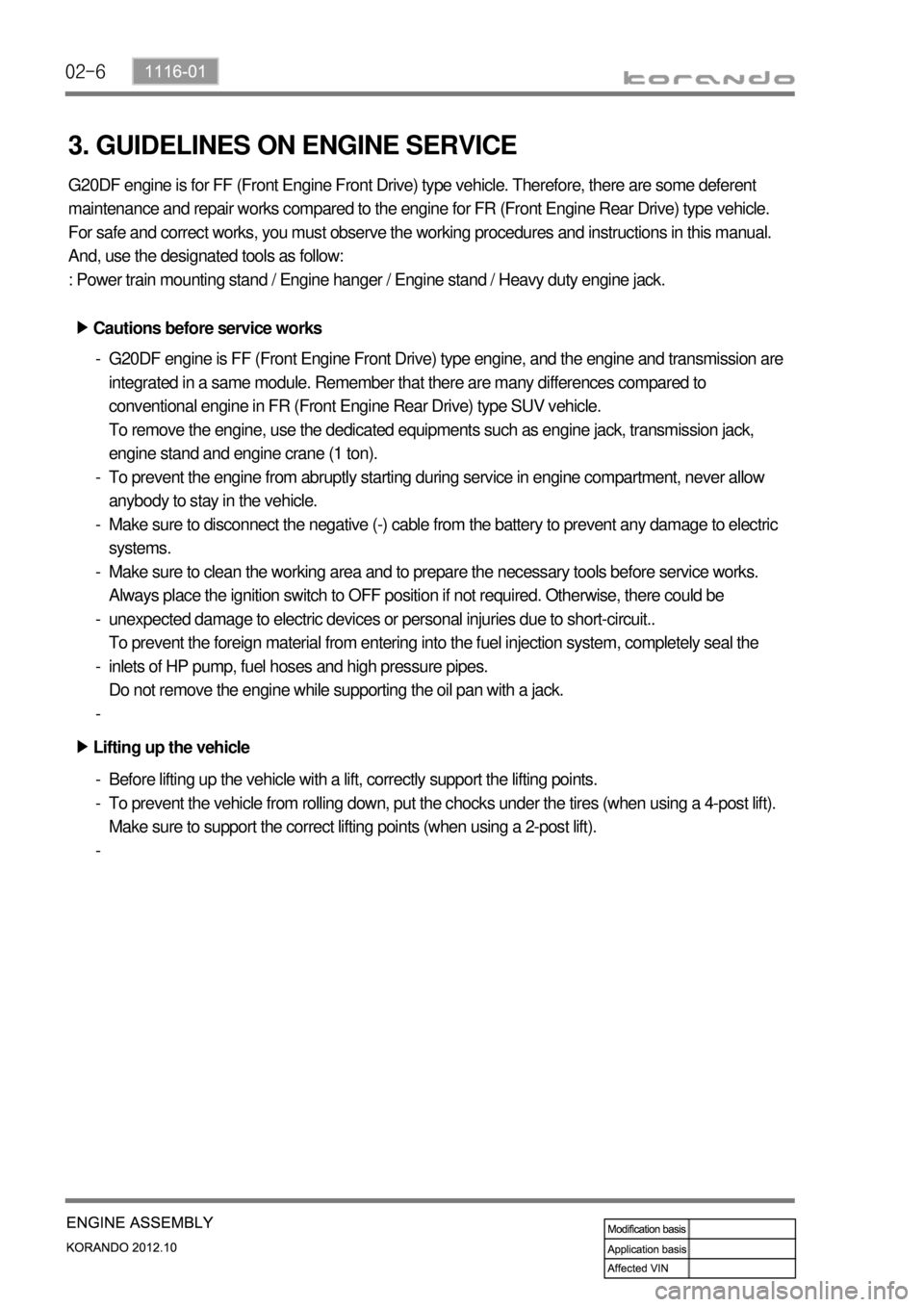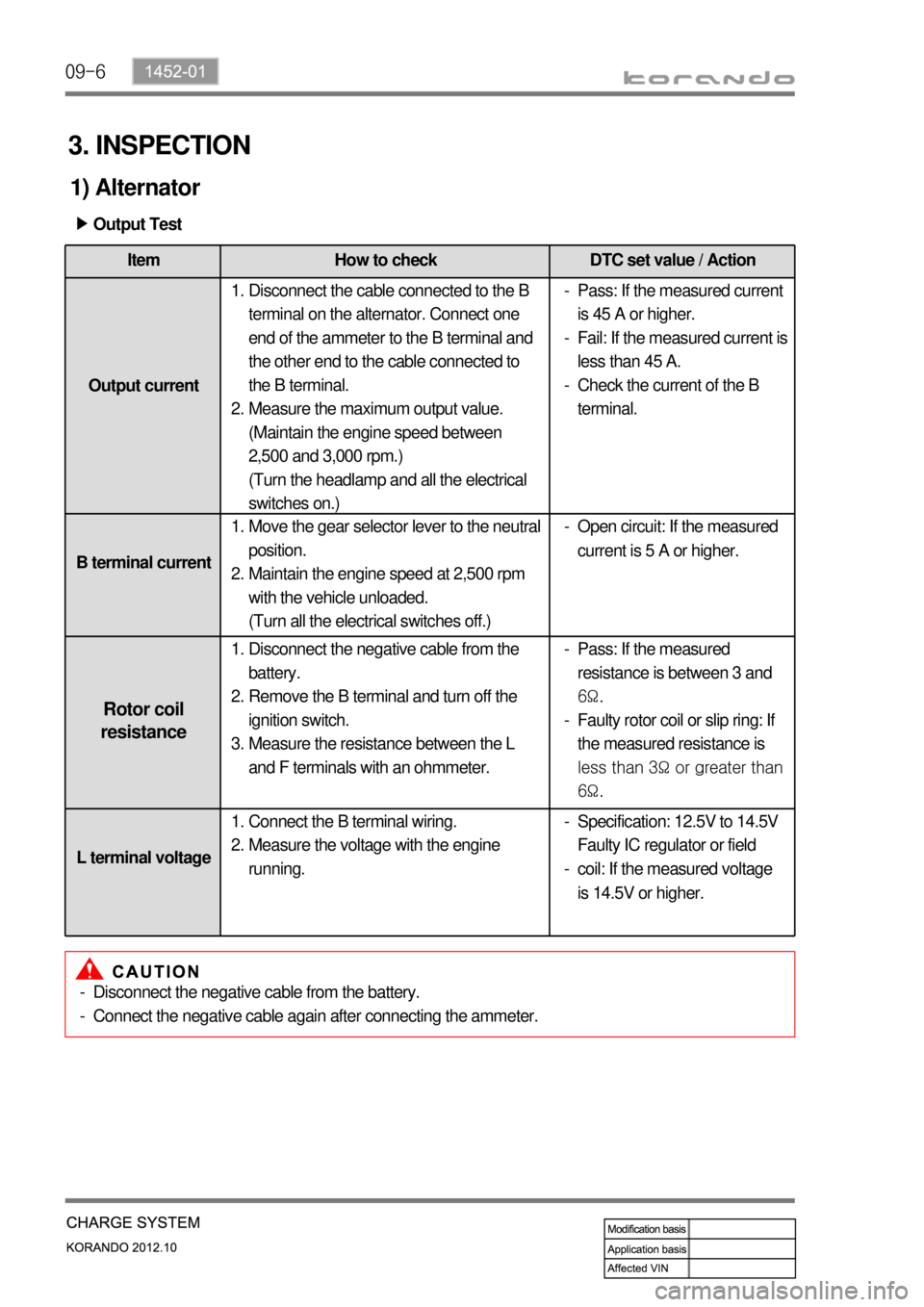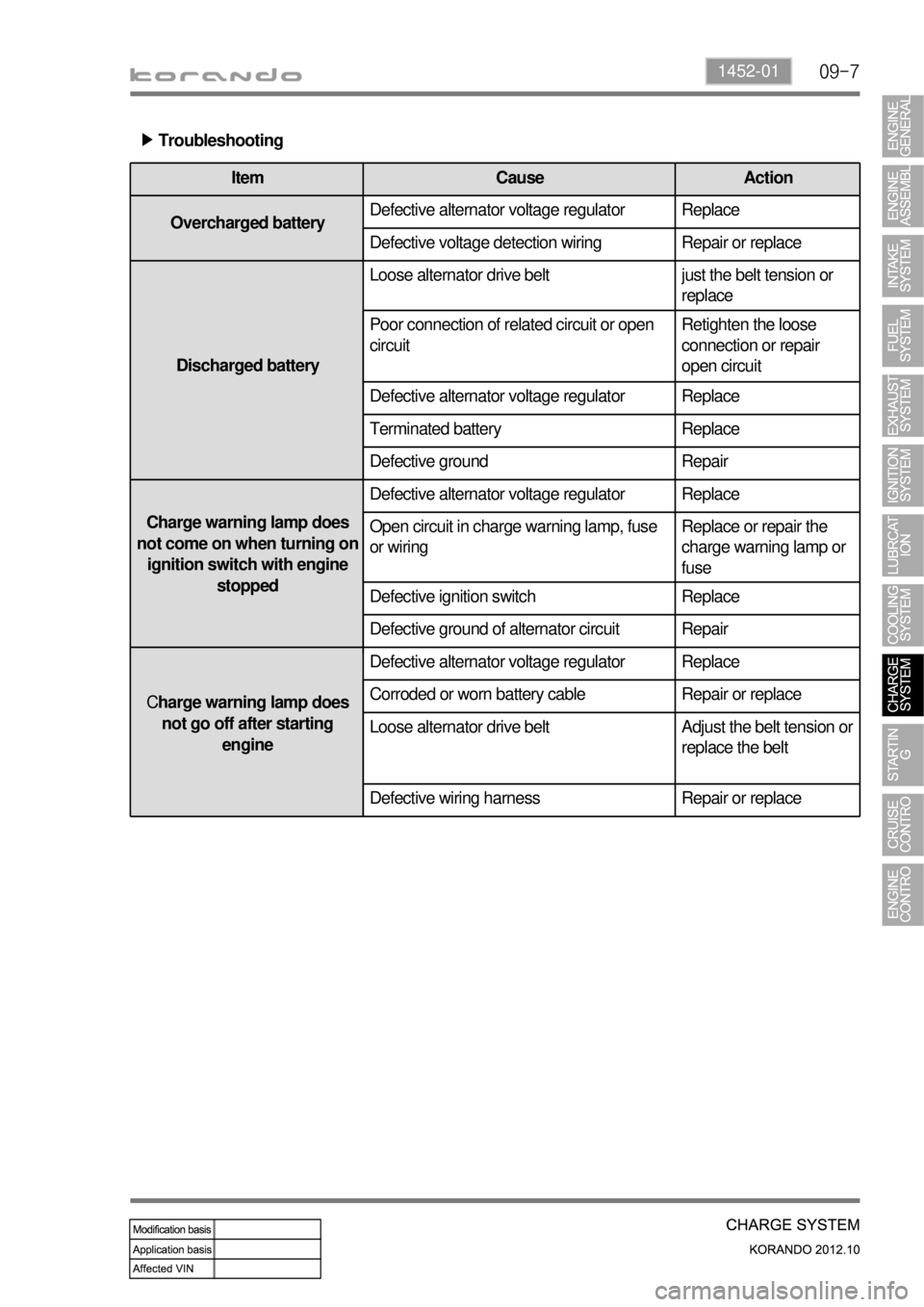ignition SSANGYONG KORANDO 2012 Owner's Manual
[x] Cancel search | Manufacturer: SSANGYONG, Model Year: 2012, Model line: KORANDO, Model: SSANGYONG KORANDO 2012Pages: 1082, PDF Size: 96.1 MB
Page 340 of 1082

01-16
3. IGNITION SYSTEM
Ignition coilIgnition plugEngine ECU
Knock sensorCamshaft position
sensorCrankshaft position
sensor
Page 352 of 1082

02-6
3. GUIDELINES ON ENGINE SERVICE
G20DF engine is for FF (Front Engine Front Drive) type vehicle. Therefore, there are some deferent
maintenance and repair works compared to the engine for FR (Front Engine Rear Drive) type vehicle.
For safe and correct works, you must observe the working procedures and instructions in this manual.
And, use the designated tools as follow:
: Power train mounting stand / Engine hanger / Engine stand / Heavy duty engine jack.
Cautions before service works ▶
G20DF engine is FF (Front Engine Front Drive) type engine, and the engine and transmission are
integrated in a same module. Remember that there are many differences compared to
conventional engine in FR (Front Engine Rear Drive) type SUV vehicle.
To remove the engine, use the dedicated equipments such as engine jack, transmission jack,
engine stand and engine crane (1 ton).
To prevent the engine from abruptly starting during service in engine compartment, never allow
anybody to stay in the vehicle.
Make sure to disconnect the negative (-) cable from the battery to prevent any damage to electric
systems.
Make sure to clean the working area and to prepare the necessary tools before service works.
Always place the ignition switch to OFF position if not required. Otherwise, there could be
unexpected damage to electric devices or personal injuries due to short-circuit..
To prevent the foreign material from entering into the fuel injection system, completely seal the
inlets of HP pump, fuel hoses and high pressure pipes.
Do not remove the engine while supporting the oil pan with a jack. -
-
-
-
-
-
-
Lifting up the vehicle ▶
Before lifting up the vehicle with a lift, correctly support the lifting points.
To prevent the vehicle from rolling down, put the chocks under the tires (when using a 4-post lift).
Make sure to support the correct lifting points (when using a 2-post lift). -
-
-
Page 354 of 1082

02-8
Fuel and engine oil system ▶
The engine oil and fuel damages the painted surfaces and rubber material of the vehicle.
Disconnect the negative cable from the battery before servicing the fuel system, and prepare the
service plug grip.
When working with the fuel or oil systems in enclosed area, always keep the working area well-
ventilated and never allow anybody to smoke.
Do not allow the gasoline to contact to rubber or leather parts.
Carefully separate the pipe between high pressure fuel pump and fuel injector so that any fuel can
be spilled out.
Fully release the pressure from the fuel system before removing any parts of fuel system.
To release the fuel pressure in high pressure line, let the engine fully cool down.
Gaskets and seals on the fuel and oil systems should be replaced with new ones. All bolts and nuts
should be tightened as specified.
Prolonged exposure to the engine oil make cause a skin cancer or an irritation.
Used engine cotains the hazardous material that may cause the skin cancer. Do not allow the used
engine to make contact with your skin.
Make sure to wear the protection gloves and goggle when handling the engine oil. If contact
happens, rinse affected areas immediately with plenty of water. Do not wash it with gasoline or
solvent. If irritation persists, consult a doctor.
Improperly disposed engine oil can pollute the environment. Dispose the used engine oil and oil
filter in accordance with local environmental regulations.
Make sure to check the connections for leak after installation. -
-
-
-
-
-
-
-
-
-
-
-
Electric devices ▶
To prevent any damage to electric systems, make sure to disconnect the negative (-) cable from the
battery and place the ignition switch to OFF position before servicing.
Use only the specified parts with same ratings when replacing the electric devices. Check the
grounds and connections for looseness. -
- Extraordinary care should be taken when servicing the electric systems. Currently, the engine uses a lot
of electric devices. Short circuit and poor contact may cause the low engine performance, incomplete
combustion and other abnormalities.
Page 405 of 1082

05-6
3. CAUTIONS
Do not park the vehicle on flammable materials, such as grass, leaves and carpet.
Do not touch the catalyst or the exhaust gas ignition system when the engine is running.
If a misfire occurs in the combustion chamber or the emission of pollutant exceeds the specified level,
the catalyst can be damaged.
When servicing or replacing components of the exhaust system, makes sure that the components
are positioned at regular intervals from all other parts of the under body.
Be careful not to damage the exhaust system when lifting the vehicle from its side.
All components and body parts of the engine exhaust system should be inspected for crack, damage,
air hole, part loss and incorrect mounting location. Also check for any deformation which can result in
exhaust gas drawn into the vehicle.
Make sure that the exhaust pipe is cooled down sufficiently before working on it because it is still hot
right after the engine is stopped.
Wear protective gloves when removing the exhaust pipe. -
-
-
-
-
-
-
-
Page 411 of 1082

06-31443-01
1. SPECIFICATION
Description Specification
Spark plugInternal resistance3 ~ 7 kΩ
Center electrode Iridium alloy
Ground electrode Platinum alloy
Electrode clearance 1.1 mm
Change interval 160,000 km
Ignition coilPrimary operating current7 ± 0.5A
Generated voltage
(primary/secondary)Max. 400 V / 5~20 kV
Ignition type Independent ignition type
Ignition sequence 1-3-4-2
Page 412 of 1082

06-4
2. LAYOUT
Ignition Coil
Bolt
Spark Plug 1.
2.
3.
Page 413 of 1082

06-51443-01
1. OVERVIEW
The ignition system is to supply high voltage generated from the ignition coil to the spark plug. The
G20DF engine is equipped with the independent type direct ignition system that the ignition coil is
installed in each cylinder.
The basic ignition timing in each cylinder is determined by the signals from camshaft position sensor and
crankshaft position sensor.
This ignition system controls the electronic ignition timing received from the engine ECU. To control the
ignition timing precisely, the ECU use the information below:
Engine load
Coolant temperature
Intake air temperature
Engine rpm
Camshaft position sensor (CPS)
Crankshaft position sensor (CKS) -
-
-
-
-
-
If the signal from the camshaft position sensor is not delivered to the engine ECU, the ignition coil and
fuel system cannot be operated.
Page 414 of 1082

06-6
2. COMPONENTS
Ignition coil
Camshaft position
sensorKnock sensorInjector
Spark plug
Page 442 of 1082

09-6
Item How to check DTC set value / Action
Output current
B terminal current
Rotor coil
resistance
L terminal voltage
3. INSPECTION
1) Alternator
Output Test ▶
Disconnect the cable connected to the B
terminal on the alternator. Connect one
end of the ammeter to the B terminal and
the other end to the cable connected to
the B terminal.
Measure the maximum output value.
(Maintain the engine speed between
2,500 and 3,000 rpm.)
(Turn the headlamp and all the electrical
switches on.) 1.
2.Pass: If the measured current
is 45 A or higher.
Fail: If the measured current is
less than 45 A.
Check the current of the B
terminal. -
-
-
Move the gear selector lever to the neutral
position.
Maintain the engine speed at 2,500 rpm
with the vehicle unloaded.
(Turn all the electrical switches off.) 1.
2.Open circuit: If the measured
current is 5 A or higher. -
Disconnect the negative cable from the
battery.
Remove the B terminal and turn off the
ignition switch.
Measure the resistance between the L
and F terminals with an ohmmeter. 1.
2.
3.Pass: If the measured
resistance is between 3 and
6Ω.
Faulty rotor coil or slip ring: If
the measured resistance is
less than 3Ω or greater than
6Ω. -
-
Connect the B terminal wiring.
Measure the voltage with the engine
running. 1.
2.
Specification: 12.5V to 14.5V
Faulty IC regulator or field
coil: If the measured voltage
is 14.5V or higher. -
-
Disconnect the negative cable from the battery.
Connect the negative cable again after connecting the ammeter. -
-
Page 443 of 1082

09-71452-01
Troubleshooting ▶
Item Cause Action
Overcharged batteryDefective alternator voltage regulator Replace
Defective voltage detection wiring Repair or replace
Discharged batteryLoose alternator drive belt
just the belt tension or
replace
Poor connection of related circuit or open
circuitRetighten the loose
connection or repair
open circuit
Defective alternator voltage regulator Replace
Terminated battery Replace
Defective ground Repair
Charge warning lamp does
not come on when turning on
ignition switch with engine
stoppedDefective alternator voltage regulator Replace
Open circuit in charge warning lamp, fuse
or wiringReplace or repair the
charge warning lamp or
fuse
Defective ignition switch Replace
Defective ground of alternator circuit Repair
Charge warning lamp does
not go off after starting
engineDefective alternator voltage regulator Replace
Corroded or worn battery cable Repair or replace
Loose alternator drive belt
Adjust the belt tension or
replace the belt
Defective wiring harness Repair or replace